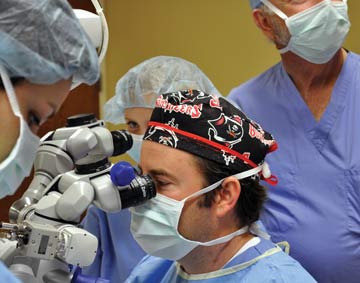Jay Horowitz, CRNA, who provides anesthesia services for ophthalmologist Hunter Newsom, MD, is in awe of the surgeon's efficiency. "It's not just speed that makes him so unusual — the top 10% of cataract surgeons can all operate quickly," he says. "What I think sets Dr. Newsom apart is his almost supernatural ability to repeat the procedure identically with each patient."
Mr. Horowitz says keeping up with Dr. Newsom requires a system of logistics, ergonomics, focused discussions and explanations with patients, and coordination with staff. A lot of it has developed into "scripts,' according to Mr. Horowitz, "I introduce myself to the patient the same way," he explains. "I ask patients questions the same way. I explain what's going to happen during surgery the same way. Doing so allows for additional time to explore any unusual answers or give explanations. Most of the staff have developed their own scripts, from the admitting staff to the pre-op nurses to the OR staff. While it sounds the same all day, it is not rote."
You'd be hard-pressed to find quicker in-and-out turnarounds in surgery than you will at high-volume cataract facilities. While these straightforward procedures aren't usually difficult for your clinical staff to perform, making sure the machine is well-oiled and keeps cranking as efficiently as possible every day is challenging. We spoke to those on the frontlines and assembled these helpful hints that might help — when you have a quiet moment to contemplate them, of course.
.svg?sfvrsn=be606e78_3)

.svg?sfvrsn=56b2f850_5)